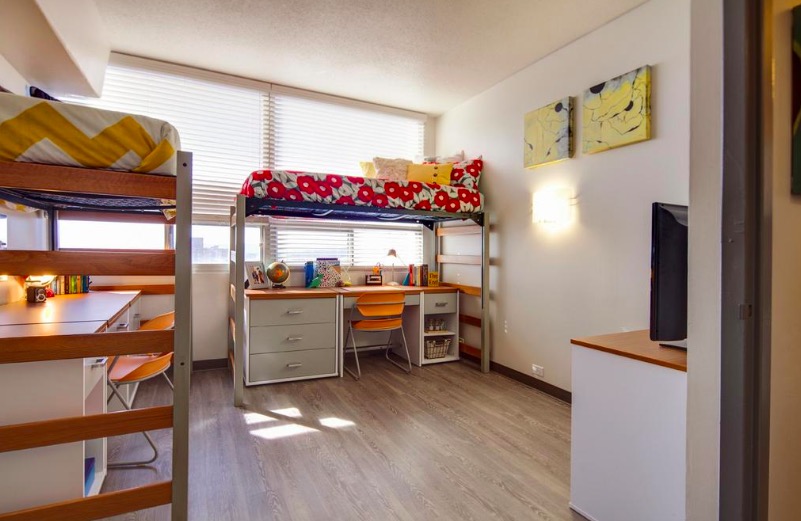The U.S. student-housing sector has been on a roller-coaster ride through the pandemic.
As some students moved off campus at the pandemic’s onset, owners of student-housing properties questioned whether occupancy — and rent collections — would fall off a cliff. Deal volume in the space dropped considerably, from about $1.6 billion in deals done first quarter of 2020, to $181.9 million the subsequent quarter, according to MSCI Real Capital Analytics.
Since then, in-person learning and students have come back to campus, as has investment in student housing. Here’s how the sector has shifted since the pandemic, and what’s driving it now.

On-campus enrollment
Demand for student housing stalled in 2020, as the pandemic drove many students out of the classroom and into a distance-education format. U.S. Department of Education data indicates that of students enrolled at four-year universities that weren’t originally entirely online, 42.7% took only distance education classes in 2021. That’s up from 15.6% in 2019, according to the data.
The state with the most dramatic proportional shift was California, where 70.8% were enrolled exclusively in distance education classes in 2020, up from 8.6% in 2019.
The 2021 school year was a different story, however. Though the Department of Education has not yet published its broad dataset for the year, most institutions were back to business as usual for most of 2021, said Robert Kelchen, the head of the University of Tennessee, Knoxville’s Department of Educational Leadership and Policy Studies. As enrollment came back, student housing as a sector has made a comeback, headlined by what observers call a “once-in-a-blue-moon” acquisition.
New York investment giant Blackstone Inc.’s (NYSE: BX) upcoming $13 billion purchase of Austin, Texas-based student-housing developer and owner American Campus Communities Inc. (NYSE: ACC) is pointed to by investors, brokers and observers of the sector as evidence of that resilience.
It is also the latest — and most high-profile — example of consolidation within the broader student-housing space, which is likely to continue, said Ryan Lang, vice chairman and head of student housing at Newmark Group Inc. (NASDAQ: NMRK).
“Big institutions have good reason to like the space, and have seen good results,” Lang said.
His group has closed 20 deals in the past week, including a 13-asset portfolio sold to a joint venture of Brookfield Asset Management Inc. and Chicago-based The Scion Group. It’s typical for institutional investors to partner with established owners and operators with specialized knowledge of a sector, including student housing.
Power Five, flagship public universities draw capital
Demand for student housing now depends more on traditional factors than the pandemic, like enrollment growth at a given institution, particularly among recent high-school graduates headed to college for the first time. And there’s one group of schools that is winning in that crowd, Kelchen said.
“It’s really the big, flagship public universities at this point,” Kelchen said.
Universities in the U.S. are dealing with a broad, accelerating decline in enrollment. The estimated number of combined undergraduate and graduate students enrolled in higher education fell 4.1% in spring 2022 compared to the prior year, marking a 685,000-student decline, according to a report by the National Student Clearinghouse Research Center. That’s a bigger drop than the 3.5% and 2.7% year-over-year dips as of spring 2021 and fall 2021, respectively.
Despite that, larger universities with access to more funding have generally done well in recent years. But while large public universities are growing their student populations, prestigious private colleges aren’t necessarily looking to expand, Kelchen said. If those private universities want more revenue, they typically get it by seeking donations or by expanding online or graduate programs, not by growing their residential campuses, Kelchen said.
“The selective private colleges have plenty of demand (for enrollment), but most of them aren’t looking to increase their enrollment,” he said. “That really leaves the big state universities as the places where there’s strong student demand and they’re willing to increase enrollment.”
There are some regional differences in growth, though they aren’t nearly as significant as the type of institution, Kelchen said. Growth has been weakest in the Northeast, and stronger in the Midwest, West Coast and much of the South, where the volume of students coming out of high school is higher, he said.

“Even (in the Northeast), some of the bigger ones seem to be doing fairly well,” Kelchen said.
Thirty-plus campuses have increased pre-lease student-housing velocity for fall 2022 by more than than 20% year-over-year, according to Richardson, Texas-based RealPage Inc. The biggest improvement has been observed in West Coast schools, major campuses in Arizona and Colorado, and a few urban-centric campuses, such as The Ohio State University and the University of Texas at Austin.
Student housing near Power Five athletic-conference schools tend to draw the biggest pool of real estate capital, owing to brand recognition, strong enrollment and other fundamentals, said Carl Whitaker, director of research and analysis at RealPage.
That means investments aren’t necessarily as geographic specific as, say, conventional multifamily, but schools in the Southeast and Southwest do tend to draw a lot of interest. In fact, Whitaker said, a likely key reason why Blackstone is buying ACC is because of its stronghold in the Sun Belt.
ACC’s portfolio, as of the Blackstone deal announcement in April, included 166 properties in 71 university markets, near schools like Arizona State University, UT Austin, Florida State University and the University of California-Berkeley.
Most of ACC’s properties are within walking distance of university campuses, with about 24% actually on campus. Walkability to universities continue to be a major draw for student-housing real estate investors, those who work in the space say. That’s because they’re popular with students: What are called pedestrian assets in student housing, or properties less than a half-mile from campus, are seeing a 13.9% increase in pre-leasing year-over-year, as of April, RealPage found.
Record fall 2022 expected, but economic headwinds persist
It’s widely expected that fall 2022 will see record rent growth and occupancy. In fact, the national fall 2022 pre-lease rate for student housing through April — 68.4% — is outperforming the 10-year average for April by more than 5%, according to RealPage.
And, through April, rent growth for student housing in fall 2022 was tracking to be more than 5.5% among RealPage’s 175 core set of campuses. That’s more than three times greater than the previous decade average, Whitaker said.
Still, it can’t be ignored the broader economic outlook has become more pessimistic, especially with rising interest rates, elevated inflation and predictions of an economic slowdown later this year or in 2023. Commercial property sales are slowing for the first time in more than a year.
Much of the first quarter of 2022 had record-low financing rates, so any deal slowdown has yet to be observed in student-housing deal volume data. Lang estimates some $3.5 billion in student housing has traded so far this year. In 2021, $11.6 billion in deals traded, according to MSCI Real Capital Analytics data, while Q1 2022 saw nearly $2.18 billion in sales completed.
Rising interest rates since the start of the year will make it tougher for groups to buy properties at recent low capitalization rates. Student-housing cap rates have stayed flat or have compressed since the Great Recession, going from 7.9% in the third quarter of 2009 to 4.9% in Q1 2022, according to MSCI Real Capital Analytics. Cap rates were at 5.5% at the end of Q1 2020, the onset of the Covid-19 pandemic in the U.S.
“The first victim … is going to be deal activity, as buyers pull back,” said Jim Costello, chief economist at MSCI Real Assets, adding sellers won’t want to adjust price expectations right away.
Tim Bradley, founder of Phoenix-based real estate finance advisory firm TSB Capital Advisors LLC, said debt is more difficult to place right now, but buyers are still looking for good real estate within student housing. Among other deals, TSB, which specializes in student housing, is serving as a financial advisor to Blackstone on the ACC acquisition.
He and others are forecasting fewer new student-housing units to deliver compared to historic norms in the next couple of years, in part because of a slowdown in new student-housing construction in the early days of the Covid-19 pandemic, as well as broader supply-chain problems. That’ll constrain supply, pushing up occupancy and rental rates.
Whitaker said, anecdotally, he’s heard from two major clients that deal terms they had agreed to 60 days prior had to be renegotiated as interest rates began to quickly rise.
“They were still getting done, but they were under different terms,” he continued. “That may influence the pace of deals but we’re not necessarily going to see a huge pullback in terms of deal interest.”
Bradley said he’s hearing about renegotiations in other deals but none his team is working on have exited or want to change terms, including a $725 million portfolio TSB closed last week.
Lang said, so far, he hasn’t observed any renegotiated deal terms within student housing because of rising interest rates, or seen any investors walk away from a deal. Real estate is still viewed as a hedge against inflation, he continued, so he remains bullish for the next few months.
But, he added, investors will likely become picker about what markets they enter and what deals they chase. Groups that’ve been on the fence about exiting a portfolio might decide to quicken their efforts to exit, especially later in the summer and into the fall, as student-housing pre-lease numbers solidify.
The Article is from Austin Business Journal, copyright belongs to owner





